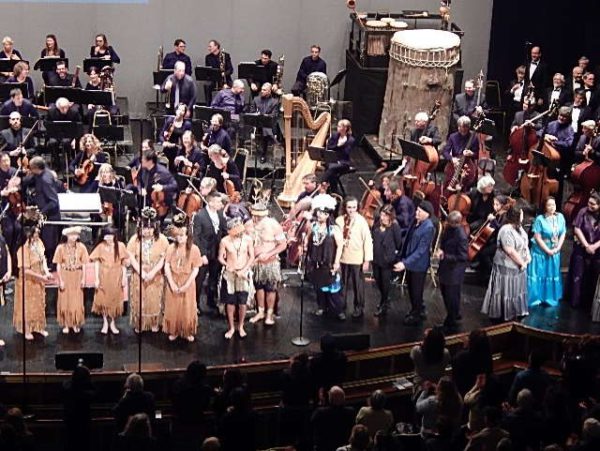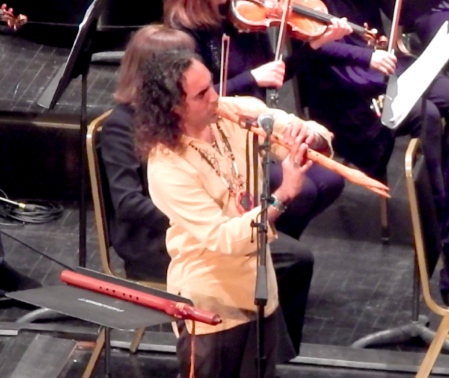 |
Canku Ota
|
 |
|
(Many Paths)
|
||
|
An Online Newsletter
Celebrating Native America
|
||
|
April 2017 - Volume
15 Number 4
|
||
|
|
||
|
Oakland Symphony
Presents "Notes From Native America" At The Paramount Theater
|
||
|
by Nanette Bradley Deetz
- Native News Online Currents, Entertainment
|
||
|
credits: photos by Charles
Lopez Sr.
|
Oakland, CA — The massive, world-wide protest's over the Dakota Access pipeline and the Standing Rock Sioux Tribe's legal response to gather the support of over 350 American Indian tribes in Indian Country and over 2,000 U.S. military veterans was the reason the Oakland Symphony chose to present "Notes from Native America." "The 'Notes From' series is designed to welcome diverse elements of the community into the symphony family. This year I chose the Native American community because it is vast and little known by most. I felt the time was right to change this", said Maestro Michael Morgan, director of the symphony.
"I wanted to learn more about our Native American people that have taken the most care of the land we all live on, yet we have been so disrespectful of for centuries. This is our way of thanking them and continuing to learn more", explained composer John Christopher Wineglass. Local community organization Intertribal Friendship House, directed by Carol Wahpepah and the youth council collaborated with the symphony by providing projected images of several flags representing tribal nations, and setting up tables where youth informed and invited the public to their numerous local events. The Big Sur Land Trust also provided an informational booth explaining the work they have done and continue to do to insure coastal land remains in trust along the Monterrey County coastline. The program began with a presentation by the SuNuNu Shinal (Huckelberry Heights) Pomo Dancers and singers. This group is composed of Kashia Pomo and Coast Miwok dancers and singers from ages 9 to 64, who have been performing cultural songs and dances all their lives. The tribe is based at Stewart's Point, California.
"We chose to present our sacred water basket dance as a tribute to those at Standing Rock. This is how we teach our children language, culture, tradition, and who they are in this world," explained Billy Rene Pinola, singer/dance teacher of the group. SuNuNu Shinal has traveled throughout California as well as European countries performing and explaining traditional California Indian culture and tradition. Noted Chickasaw composer/musician Jerod Tate presented part of a larger epic piece entitled "Lowak Shoppala' or Fire and Light" part VII Hymn and part IV Clans Libretto.Tate is a citizen of the Chickasaw Nation of Oklahoma, and is a 2011 Emmy Award winner, along with other awards and commissions too numerous to mention. He was appointed Creativity Ambassador for the state of Oklahoma in 2008. Tate is dedicated to the development of American Indian classical composition to tell the history and share the culture of the Chickasaw Nation. "Lowak Shoppala' or Fire and Light expresses Chickasaw identity through modern classical music and theater. "Hymn VII" is a dramatic/operatic homage to Southeast Indian hymns sung in Indian churches. The Chocktaw hymn presented was composed during the Removal into Oklahoma, and members of the Oakland Symphony Chorus, directed by Lynne Morrow, sang the vocal score in its' traditional language. Linda Hogan, noted Chickasaw poet, writer, play write, academic, environmentalist, who is now the Chickasaw Nation's writer-in-residence, wrote the script for the piece, "Clans". In Chickasaw culture, a family clan system was maintained through matrilineal descent. The piece presented focused on seven of the family lines, with projections on a large screen in the Chickasaw language. Those presented were Chief, Bird, Alligator, Squirrel, Skunk, Panther, Raccoon, and circled back to Minko or Chief. Linda Hogan's writing is poetic, metaphoric, and infused with the natural world.
The introduction said, "we have all been given the fire. Let us burn our way into the world, let it light our dreams. It will take us beautiful and grace-filled through the future, the ones our grandmothers and grandfathers dreamed for us as they journeyed, as they carried us inside them in the time before ours". Minko or Chief began, "I stand in the green world, it's strands woven in all our breaths, the delicate, the strong…we are beautiful people, look how we make a path for those we care for, light a fire, sweep the path between us, human, all my people it is time for the story of a night of telling, the word another seed". The musical score was composed in minor keys with chorus and narration flowing together perfectly. Narration was performed by Vincent Medina, Chochenyo Ohlone, who spent many years of research and linguistic study to re-learn and teach his native language to others. Medina serves on numerous boards in the East Bay and is a Curator at Mission Dolores in San Francisco. He also serves as a radio host on KPFA's Bay Native Circle. Composer John Christopher Wineglass created a tone poem entitled, "Big Sur: The Night Sun", while in residence at Glen Deven Ranch and Pfeiffer Beach. The Ohlone refer to the moon as the night sun. The piece is written in four movements, "Mystery of the Night Sun", "Rushing Waters", "Pfeiffer Beach-A Secret Revealed" and "The Return". Wineglass is a recipient of three daytime Emmy Awards for Outstanding Achievement in Music Direction and Composition for a Drama Series, and three ASCAP Film and Television Awards. He also holds seven Emmy nominations. "After spending time on the land, I felt that something was missing. I was haunted by the land, and needed to meet some of the original people who lived their lives in such magnificent areas. When introduced to traditional singer/artist Kanyon Sayers-Roods (Costanoan Ohlone and Chumash) I knew the piece would integrate improvisation into a classical mode, as well as traditional Native language and style of song. I really wanted to shake things up, by stretching classical music. I knew the Oakland Symphony would be open to new areas of music and sound" explained Wineglass. The piece began with Kanyon Sayers-Roods vocalizing the sounds of eagle, hawk, crow, fox, and coyote while cedar bird flute player Emilio Campobello played flute. Sayers-Roods improvised sounds of morning and evening with clapper stick and rattles, then sang the Grandmother Song in her language. She is the daughter of Ann Marie Sayers, and was raised in Indian Canyon, CA, trust land of her family. She speaks her language and holds traditional knowledge as well as holding a B.S. in web design. Cedar bird flute soloist Emiliano Campobello is a recording artist whose recordings were nominated for several Native American Music Awards and he received the Silver Arrow Award for his contributions to the Native American Music industry. The two drums talking at the beginning of the piece were performed
by noted percussionist Marci Chapa, who performed with Beyonce,
Alicia Keys, Jay Z, Jill Scott, the late Al Jarreau, among many
others. Her television credits range from "The Late Show" to "The
Oprah Winfrey Show" and she has graced award stages that include
the Grammy's and Billboard Music Awards. Jayon Fann, is a multi-instrumentalist, percussionist, and drummer who has music and television credits too numerous to mention. For the piece "Big Sur: The Night Sun, Mr. Fann constructed a seven-foot tall drum made from a fallen redwood tree. It's visual presentation and sound were breathtaking. Fann has toured and performed worldwide to over thirty countries in the last four years. "Notes from Native America" was an exceptionally creative, lyrical and beautiful tribute to the many tribal nations who stood and still stand with Standing Rock. Not only was it a sold-out event, but it generated pride in local Native American community and showcased the accomplishments and creative talents of American Indian people. |
||||||||
|
|
|
|
||
|
|
||
| Canku Ota is a free Newsletter celebrating Native America, its traditions and accomplishments . We do not provide subscriber or visitor names to anyone. Some articles presented in Canku Ota may contain copyright material. We have received appropriate permissions for republishing any articles. Material appearing here is distributed without profit or monetary gain to those who have expressed an interest. This is in accordance with Title 17 U.S.C. Section 107. | ||
|
Canku Ota is a copyright ©
2000 - 2017 of Vicki Williams Barry and Paul Barry.
|
||
 |
 |
|
|
The "Canku
Ota - A Newsletter Celebrating Native America" web site and
its design is the
|
||
|
Copyright ©
1999 - 2017 of Paul C. Barry.
|
||
|
All Rights Reserved.
|
||



